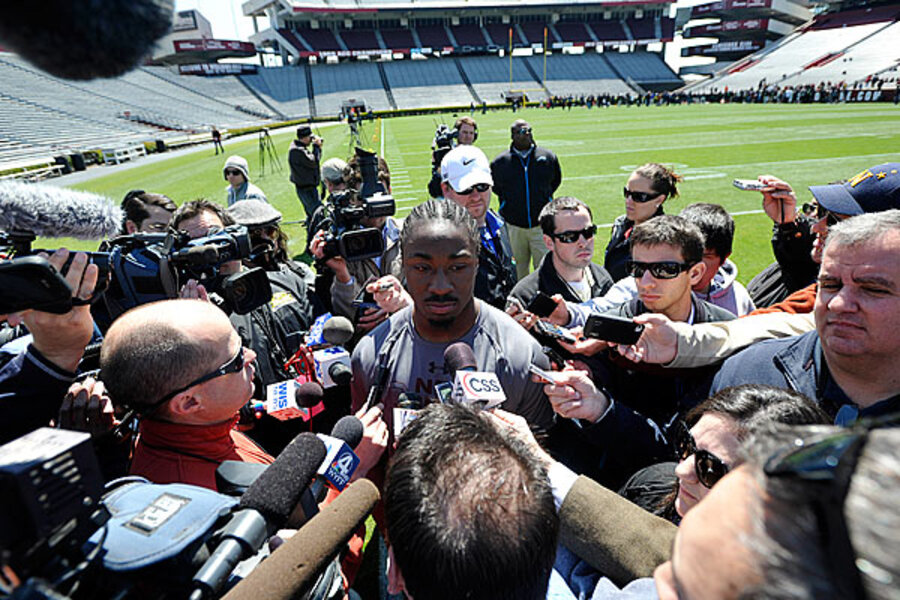Tyler Bray, Marcus Lattimore show opposite emotions of 2013 NFL Draft
Loading...
Somehow, University of Tennessee quarterback Tyler Bray – a 6-foot-6 specimen with a cannon arm – was not selected in the seven rounds of the 2013 NFL Draft.
Somehow, University of South Carolina running back Marcus Lattimore found two knees to stand on at his pro workout earlier this spring – enough to get him a standing ovation from the coaches and scouts present and a selection by the San Francisco 49ers in the fourth round.
In a draft where 63 players from the Southeastern Conference (SEC) were selected – a record for any college football conference – two of the SEC players who made the biggest splash on the last day of the three-day extravaganza Saturday did it for opposite reasons.
Bray was left standing at the altar. Admittedly, this was not a sterling draft for quarterbacks. But perhaps that's why he decided to leave Tennessee a year early year to go pro. According to one mock draft, NFLDraftScout.com, he was seventh best pick of the litter. In the end, he wasn't even among the 11 chosen.
It's a glimpse into a situation that plagued basketball for years. Many high school players, egos inflated by friends and hangers on, would enter the National Basketball Association draft, forgoing any college eligibility. When they were not drafted – or drafted late and then let go – they would be left in a limbo, not good enough to make a pro team, but not able to go to college to hone their skills.
The situation forced the NBA to institute a "one year in college" rule for all players, giving each time to assess his draft prospects with clearer eyes. The NBA has also started a developmental league akin to the baseball minor leagues to help those who fall through the cracks.
In the end, Bray was signed by the Kansas City Chiefs after the draft – and as a junior, he had ample time to make an informed decision about his pro prospects. But the National Football League also has a Draft Advisory Board precisely for this reason. It offers undergraduate prospects an impartial assessment of where they're likely to land in the draft.
"It is likely that Bray filled out the application to receive his Draft grade from the NFL Draft Advisory Board and that he was told he was likely to be selected as high as the third round. The opinion of the Board is confidential; unless Bray or his agent speaks on the record, there is no way of knowing whether Bray went through the process and/or what he was told," writes Darren Heitner of Forbes.
For Lattimore, however, the prospect of playing any football at all has to be a joyous one. At one point, he was slated to be the top running back taken in this year's draft. Then he became the Kevin Ware of the college football season, suffering a gruesome leg injury that ended his playing year. According to medical reports, he's unlikely to play much – if at all – in 2013 because of his knee.
But in San Francisco, he'll have time – and a mentor. When Lattimore tore his knee, one of the first pro players to call with a message of support was running back Frank Gore, who had two major knee injuries while at the University of Miami. Now, as a 49er, Gore is a four-time Pro Bowler and Lattimore's teammate.
"I know I'm going to get to know him a little better once I get there," Lattimore, speaking from Columbia, S.C., said a conference call Saturday, according to a USA Today report. "So I'm real excited about that."
And Lattimore isn't the only inspiring story coming from the 49ers this weekend. Shortly after the draft ended, the 49ers signed British Olympic discus thrower Lawrence Okoye. Okoye has never played football. But he is a beast.
Trying to describe him, 49er coach Jim Harbaugh said, "Just an Adonis," according to a USA Today report.
At 6-foot-6, 308 pounds, Okoye runs a 4.78-second 40-yard dash. Now, the task is to teach him how to hone those abilities to make him a defensive end in the NFL. It's a project, no doubt. But his physical tools make it worth the minimal risk.






